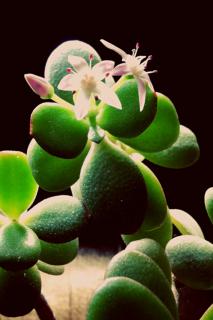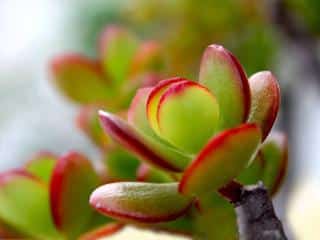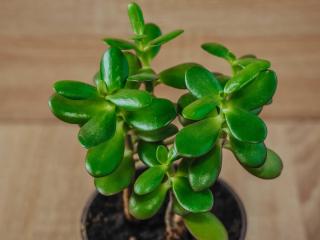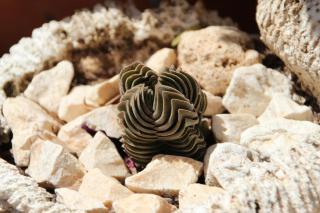

Crassula is an indoor succulent plant family that displays surprising evergreen leafage.
Key Crassula facts
Name – Crassula
Family – Crassulaceae
Type – succulent plant
Height – 8 inches (20 cm)
Soil – light, well-drained
Exposure: well-lit – Foliage: evergreen – Flowering: summer
It shows up in more and more places for its very trendy ornamental value. Caring for it is something anyone can succeed in, even though to keep it beautiful these tips will be very useful.
Careful planting in the right soil is the key to a long-living crassula.
Crassula is most often native to South Africa and adapts well to mild climates.
It is preferable to grow your crassula indoors if you expect freezing over the winter. Indeed, the slightest frost would kill it.
 Crassula can be propagated by preparing cuttings from young stems.
Crassula can be propagated by preparing cuttings from young stems.
It is usually quite easy to get the crassula to sprout roots.
Although caring for crassula is straightforward, a few tips will help you grow a very nice, long-living plant:
 Prune your crassula when the branches get old or look weak.
Prune your crassula when the branches get old or look weak.In any case, it is important to wait for the soil to have dried well before watering, in which case it is also better to water once rarely with a significant amount rather then having many smaller watering sessions.
BE CAREFUL! Leaves from succulents are loaded with water. If they start collapsing or drooping over, it’s a sign to water again!
Crassula varieties are numerous and varied. There are hundreds of them!
 The most famous is Crassula ovata, also called the Jade Plant .
The most famous is Crassula ovata, also called the Jade Plant .Other interesting species include:
 On top of this, many fascinating hybrids exist that rival in color, shape and bloom for the greatest pleasure of all succulent fans!
On top of this, many fascinating hybrids exist that rival in color, shape and bloom for the greatest pleasure of all succulent fans!
Native to either South Africa or Mexico, depending on the variety, Crassula is a very beautiful succulent with particularly appealing leaves.
With its reduced need for care, it poses practically no difficulty to the caretaker.
Although excess water is what most often kills it, it also like having a lot of light, but not scorching direct sun, as when behind a window.
You can set it in a pot or a garden box, along edges or on rocky ground.
If ever you mistakenly break a leaf off, simply rest it atop soil and mist it from time to time. It will sprout roots and give rise to a new plant!
thanks for Such an amazing guide, I have a jade plant which looks not happier now a days, I found black spots on the leaves of my jade plant is this a mealy bugs attacks.
Mealybugs aren’t black, they’re usually cottony white or light gray, but it might be another type of scale insect like the armored or soft scale. Perhaps it looks like the one that also made a black spot on a zz plant. If that’s the case, you can try following the instructions in those articles to heal your plant.
Thank you for your kind response I am going through your recommended articles
On, a side note, I just joined, your site…AMAZING! I can spend hours on here!
Thank you, for all of your advice!
Originally, I had her in a round clay pot, perfect for her size at the time, in a macrame hanger. I have now transplanted her to a ceramic pot half filled with small pebbles and a three inch mixture of potting soil.
I’ve been keeping her outside, since it is so humid, but in a shady area, and she seems to be happy. I have been misting her throughout the day as well.
I bring her in at night and put her in a place where she receives indirect sun.
Only time will tell to see how well she recovers.
That sure sounds like the right way to go!
I have, what I just came to realize, as a crassula coral plant. I had it hanging in a window, which receives, alot of summer sun, in the afternoon.
I didn’t pay much attention to it (I feel horrid now), because of it’s obscure location. I ignorantly assumed, that because she was green, she was doing ok.
However, when doing my weekly watering, of my plants, I noticed that it had aerial roots (I just learned, what they were today, as I have never seen/heard of them, before), at certain place, along her stalks (?)
When I checked, roots, they seem to be missing, also, most of her stalks, were shrivelled.
I cut off, the shrivelled parts, and noticed new growth, coming in, in other places.
My question is. Is there any chance, that I may be able to save her, if she is indeed dead?
The only thing, that I could think, of doing, to increase, her chances, of survival, would be to lie her, on her side, in her pot, and burying the aerial roods.
Any help, would be very appreciated
Hi Lisa! Sounds like an interesting “case”!
Aerial roots are definitely a sign that something is missing down below. Usually it happens when:
– there isn’t enough soil or the pot is too small. We’ve had that on a kalanchoe that wanted to tell us it needed repotting :p
– there hasn’t been any watering for a long time.
– the plant is rootbound and roots are choking each other out.
– for succulents, this also happens when the lower part of the plant is rotting. Indeed, root rot interrupts flower of water to the top. Branches higher up try to send out new roots to answer their needs for water.
Your idea of repotting the stem with the aerial roots is just what the plant needs! The main stem may have died, but the side shoots sprouting roots are still very much alive. Take great care to handle the plant carefully since the roots are very fragile.
– mist the roots to soften them up a bit (spray with water) about 20 minutes before you start working on the plant. This will reduce breakage.
After that, pot as usual with a very well-draining soil mix (sand, pebbles and just a little soil). I would recommend replacing the soil entirely and rinsing out the pot with soap, in the off chance some root rot fungus had earlier weakened the plant.
Do try to start cuttings from any leaves or pieces of stems that still look healthy and feel firm. They’ll make cute gifts for the Christmas season!